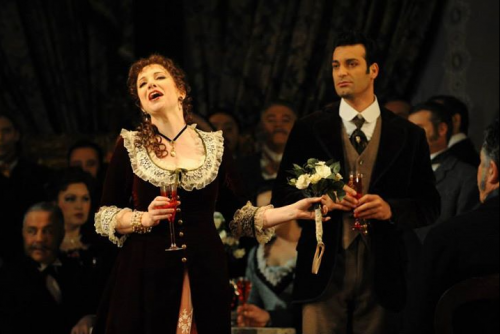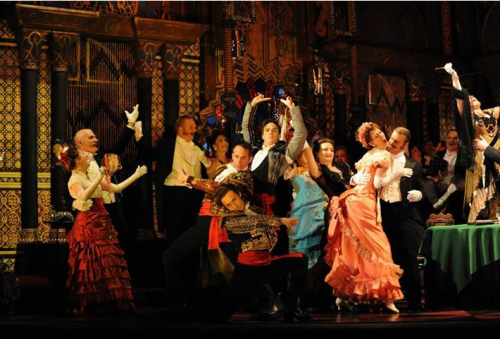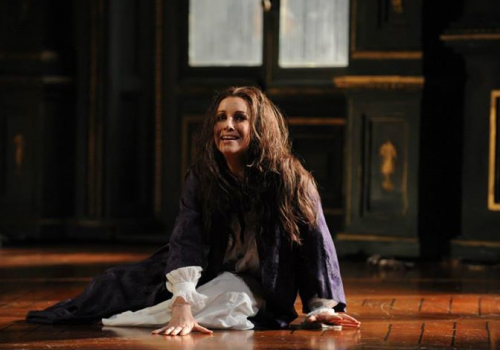THIS powerfully realistic production directed by Elijah Moshinsky has been in Opera Australia’s repertoire since 1994, and it remains one of the company’s most popular.
But in this 2015 revival by Tama Matheson, electrified with vibrant casting at the top, Verdi’s enduring opera seems to have taken on new life, and it would be falsely modest not to mention that Friday’s opening night in Sydney was an extraordinary triumph for Canberra soprano Lorina Gore in the role of the tragic Violetta, the wayward woman of the title.
But first to Moshinsky’s production per se. Respecting the composer’s wish for the opera to be contemporary to 1853 and not set back in the 18th century to avoid public squeamishness about depicting the half-world of French courtesans, the director and his designer Micheal Yeargan conjured up French impressionist paintings showing the lifestyle enjoyed by courtesans and their patrons in a near-cluttered set that suggested conspicuous consumption. The spare tastefulness of the Act II autumn scene in the country and the final act where we see Violetta’s Paris apartment stripped bare show the intention of the creators.
The plot also deals with another kind of consumption, that experienced by the tubercular heroine as she faces her inevitable death with rare spirit. “La Traviata” was based on Alexander Dumas fils’ novel “The Lady of the Camellias”, itself based on a true story that was too close to the bone for Verdi’s first audiences. While the librettist Piave cleaned up the sordid elements in the novel considerably, the director makes no secret of Violetta’s illness and we see blood on the hands and the handkerchief of the heroine. Even the champagne is the colour of blood.
The characters are played out in a spirit of true verismo. In Act I, the heroine appears seamlessly out of the crowd, a little tipsy, as you might imagine a real courtesan to have behaved. The dashingly handsome young tenor from Kosovo, Rame Lahaj, looks and behaves like an ingenuous young suitor besotted with a celeb. Indeed so far are the pair from the old-style portly soprano and tenor that there was an audible intake of breath as their eyes first met.
The reactions between Alfredo and Violetta are subtle and convincing, contrasted with the extroversion of the society in which they are placed and the director’s seasoned approach to these relationships comes to the fore in Acts II and IV.
In Act II, the autumn scene, Lahaj/Alfredo enjoys a rare moment at centre stage with a potent rendition of “De’ miei bollenti spiriti / Il giovanile ardore”, while baritone José Carbó plays Alfredo’s father Germont with rare sensitivity and a quiet touch that has us almost sympathising with him as he convinces the heroine to abandon his son for honour’s sake. This is a most moving act, consummated by Gore’s rendition of “Amami, Alfredo, amami quant’io t’amo” as she leaves a lover.
Gore, though magnificent as a coloratura soprano in the early moments of the opera, comes into her own dramatically in the very final act when she gives a credible performance as a woman dying of tuberculosis, with her farewell aria, “Addio, del passato bei sogni ridenti” both full-blooded and desperately frail. The brief appearance of Carbó/Germont makes good the notion that Violetta has become a true daughter to him.
A false moment of vigour as she is reunited with Alfredo paves the way for a shattering scene of death.
No doubt this is a production with moments of colour and spectacle and many small cameo roles that add to the sense of realism conveyed. But I would rate the quieter, more sensitive scenes as the greatest achievement of this “Traviata”, with a delicate hand from conductor Renato Palumbo that perfectly matches the realistic acting and singing of the principal artists.
All photographs by Branco Gaica for Opera Australia.
The post True verismo in Gore’s ‘Traviata’ appeared first on Canberra CityNews.



